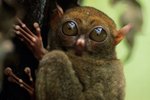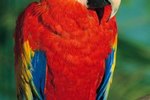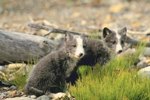
Australia has some of the most dangerous animals in the world, and it also has the only mammal that moves by bouncing: the kangaroo. The kangaroo is the emblem of the country and its national airline Quantas, and fictional kangaroos are among some classic characters of children's books and television, such as Roo and Kanga in "Winnie the Pooh," and Skippy the Bush Kangaroo. Kangaroos not only are popular and numerous, the family has quite a few species.
The Kangaroo Family
Kangaroos belong to the superfamily Macropodoidea, which also includes wallabies. This superfamily has 62 members native to Australia and Papua New Guinea, ranging in size from those who weigh as little as 2 pounds to about 200 pounds. Six kangaroo species are the big boys of this family, although a new, and slightly smaller, kangaroo family member was discovered in Papua New Guinea in 1990. The wallaroo, a crossbreed of wallaby and kangaroo, is another relative.
Red Kangaroos
The red kangaroo is the largest species. The male weighs in at around 200 pounds and stands 6 feet tall, sitting on his haunches. The female measures 4 feet and weighs around 77 pounds. This kangaroo prefers to live in desert and semi-arid habitats, and you'll also find him in open grassland and shrubland areas around central Australia. Black and white lines on either side of his muzzle, and a white stripe that runs from his mouth to ear distinguish him from other species. His long back feet allow him to hop at speeds of up to 40 mph. His diet consists mainly of plants and foliage, and he gets most of his water from his food sources. Indeed, he needs very little drinking water, which is useful in his arid habitat. Drought is the biggest threat to this kangaroo because it destroys his food supply. Otherwise, the red kangaroo population is plentiful and certainly not endangered.
Grey Kangaroos
The Grey kangaroo is the next largest. Two species, the Western and Eastern grey, belong to this family. The Western kangaroo lives as you might expect in Western Australia, but the Eastern kangaroo likes forest and grassland areas of Australia's east coast, and is the only kangaroo species on the island of Tasmania. The species has a woolly textured coat, compared to the Red kangaroo's silkier one, and is a grayish-brown color. Males measure up to 5 feet in height and weigh about 145 pounds. Females are only 4 feet tall by comparison and weigh in at 77 pounds.
Tree Kangaroo and the Wallaroo
Australia's close neighbor, Papua New Guinea, is another home for kangaroos. In 1990, zoologists found a golden-mantled kangaroo species in the island's Torricelli mountains and in 2005 more of these tree dwelling kangaroos were found in another part of the island. The WWF reports that, unfortunately, some 99 percent of the golden-mantled species' habitat has been destroyed and numbers are dangerously low. He's chestnut colored with a gold-colored double stripe down his back and, unlike his larger Australian relatives, weighs a mere 32 pounds. In total there are 13 tree kangaroos species in Australia, Papua New Guinea: all face the same threats of habitat loss.
The stocky wallaroo, with his shaggy coat and short limbs, is well-adapted for leaping around rocks. He lives all over Australia, but prefers living in hilly areas and makes his home in a cave where he can hide from the heat and predators. Although he may like having a watering hole nearby, he can survive for up to three months without drinking water, relying on plants as a water source.
References
Photo Credits
-
Jupiterimages/Photos.com/Getty Images
Writer Bio
Based in London, Eleanor McKenzie has been writing lifestyle-related books and articles since 1998. Her articles have appeared in the "Palm Beach Times" and she is the author of numerous books published by Hamlyn U.K., including "Healing Reiki" and "Pilates System." She holds a Master of Arts in informational studies from London University.




